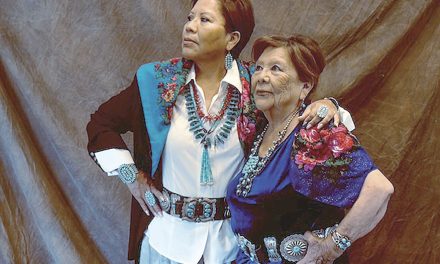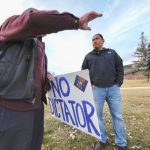
Proposed ‘glamping’ resort using teepees, hogans stirs controversy

Submitted
This photo shows the inside of one of the “covered wagon” rooms that will be part of the Historic Two Guns resort if approved.
TWO GUNS, Ariz.
A proposed luxury “glamping” resort could soon be coming to Two Guns if the Coconino County Board of Supervisors approves the required “resort commercial” zone change at its meeting next Wednesday.
Glamping, which pairs “glamorous” with “camping,” has become popular with travelers who long to experience outdoor adventure and recreation in a natural setting, but with amenities one might find in hotel resorts. “Glamping and RV camping has grown in leaps and bounds during COVID,” said “Historic 2 Guns” developer John Gunderman, who hails from Indiana. “It’s outdoor hospitality that’s the closest thing to pandemic-proof. That’s what people are looking for.”
The board’s vote on the project was stalled last December amid concerns over the use of Native American themes, including fully outfitted teepees and covered wagons for lodging.
The idea drew criticism from District 5 Supervisor Lena Fowler, Diné, who suggested the concept was disrespectful and perpetuated Native stereotypes. Since then, hogans have been added to the list of lodging options, adding fuel to fire.
Often referred to as a ghost town, the abandoned Two Guns tourist stop is located on the east rim of Canyon Diablo just off Interstate 40. While Two Guns is not on reservation land, it is ancestral to the Navajo, Hopi and Apache and is rich with artifacts, history, and lore, including the Apache Death Cave, where it is said 42 Apaches were killed by Navajos in 1878 as retaliation for a raid. Many people stay clear of the area because of its fraught history.
Gunderman, who now lives the recreational vehicle lifestyle, founded JDG Investments in 2018 with the vision of developing the premier luxury glamping and RV resort. The Two Guns site was chosen for its location on Route 66 (I-40) that could complement Meteor Crater and Navajo Twin Arrows Casino Resort as a tourist attraction between Winslow and Flagstaff, he said. “I’ve committed my life here,” said Gunderman. “I walked away from my successful business back home and my family and friends. This is my baby. I’m all in.”
The proposed 247-acre resort would offer a large array of furnished camping and lodging options, including the 78 teepees, 12 hogans, 42 Conestoga wagons and dozens of cabins, bungalows, yurts, big timber wall tents, tree houses, and vintage Airstream campers. “There is something perfect for every family, group, and club,” states the historic2guns.com website. Gunderman said the teepees would have concrete floors, heating and air-conditioning, king-size beds, and full bathrooms.
“It’s completely different than anything that would ever be used for ceremonial use,” he said. The master plan also includes two hotels, over 400 “state of the art” RV spots, an equestrian center, mini-golf, a water park, pet resort, chapel, shooting gallery, drive-in movie theater, heli-pad, “steakhouse/saloon, cantina,” a family reunion center, a Native American interpretive center that will “pay homage” to the local Native culture, and a military museum to honor veterans, with special attention paid to Navajo Code Talkers. The resort will host special events for up to 200 people, such as weddings, in specially designed larger scale “event teepees” named “The Maiden,” “The Medicine Men” and “The Chief.”
If that isn’t enough, there will be an events plaza where Native American vendors can sell their wares and numerous activities will be offered such as Native American dances, stargazing and storytelling. Financially, the resort is projected to bring in a whopping $350 million in economic benefit to the area annually, said Gunderman, and he intends to set aside $5 million a year to give back to the community through various charities. As a “good neighbor” Gunderman wants to support local food banks, homeless shelters and other philanthropic investments.
“We will be working with Shriners, Make-A-Wish and St. Jude on this Project to make life a little better for the children,” said Gunderman.
‘Show and tell’
Navajo Nation Council Delegate Thomas Walker, who met with Gunderman about the project, didn’t mince words. “His ideas are misguided at best,” said Walker. “It’s almost a show-and-tell project to attract curious travelers from all over the world. But these aren’t Native, Indigenous peoples who are offering that. This is a profit-making business.
“The nearby communities and the Navajo Nation will have something to say about it,” he said, “and it will be statements of concern.” Walker suggested the proposed use of Native American-themed lodging places could be viewed as a form of sacrilege by many Navajos. A hogan is not just a home, but a sanctuary, he said, and represents the worldview of Navajos and is a symbol of the culture. “It’s in the image of the Navajo universe,” said Walker. “Everything that we see connected to the earth, the sky, the heavens, the mountains are all depicted in the hogan.” To use them for commercial purposes is not acceptable, he said.
Teepees are also sacred to Navajos who participate in Azee Bee Nahagha ceremonies for “healing, good living and strength,” said Walker. Walker, who happens to be president of the Birdsprings Chapter’s Azee Bee Nagahga Diné Nation (formerly Native American Church of Navajoland) and a legislative advisor to the Diné Hataalii Association, said Gunderman chose to talk with him because he is a delegate. He said the developer seemed naïve to the long history of “settlers” coming to the area with big dreams and promises that haven’t always served the Native communities well.
The Navajo Nation President’s Office told the Navajo Times that the Navajo Historic Preservation Department is recommending “a full cultural resources inventory of the project area” be completed and shared for review. “The Navajo Nation has no jurisdiction over the lands described in the proposed project,” said Richard Begay, who heads up the NHPD.
“It is up to the company to select a company to do that before any development activities.” Jared Touchin, communications director for the president’s office, said President Jonathan Nez has not met with the project developer. “I understand ‘tours’ were offered last week, but President Nez was occupied with first lady Jill Biden’s visit during those times,” said Touchin.
In a Dec. 17 letter, the Hopi Tribe requested the Coconino County Board of Supervisors deny the request for zone change for the proposed glamping resort, saying the tribe claims cultural affiliation as the First People in the area, and the project is not suitable as it is inconsistent with the surrounding land and peoples’ existing character. Stewart Koyiyumptewa, manager of the Hopi Cultural Preservation Office, stated that Canyon Diablo is a “traditional cultural place” of the Hopi Tribe. “This property is near numerous Hopi ancestral sites,” said Koyiyumptewa. “These sites are a testament to the Hopi people’s continued stewardship of this area over thousands of years, manifested by the ‘footprints’ of habitations, trails, artifacts, petroglyphs, and the physical remains of buried Hisat’sinom.”
‘A big project’
Gunderman says the resort offers an opportunity to teach the cultural history of the local tribes and the Route 66 corridor to visitors. “You can share a rich Native American culture with people who don’t have a clue,” he said. “If it’s presented properly and done properly, why would you not want to educate generations and different cultures across the world?” Along those lines, Gunderman said he wants to invite elders and medicine men from the Navajo Nation to come share stories.
“There are so many potential good things that can come out of this,” he said. He is also committed to employing a local workforce at the resort, hiring Navajos to build the hogans, and using Navajo brands such as Navajo Beef. “It’s a big project and we’re looking at having somewhere between 150 to 175 full-time team members and 50 to 75 seasonal team members,” he said. “I’m trying to offer opportunities to the Nation in a big way.” To “show respect to the land” and “protect Mother Earth” Gunderman is committed to energy conservation and utilizing solar power and hi-tech waste incinerators for trash disposal. If the zoning change is approved by the Board of Supervisors, conditions require a cultural resource review by an archaeologist be completed, development in and near the rim of Canyon Diablo be prohibited, and formal consultation with the Navajo, Hopi, and Apache take place.
Gunderman gave assurances that the “desecrated” Apache Death Cave will be closed off and given the “reverence it deserves.” “No one is going to be permitted to walk into the cave,” he said. However, Gunderman intends to preserve a colony of bats who dwell there.
‘Being an outsider’
In December Supervisor Fowler asked Gunderman to reach out to the Navajo Historic Preservation Department, Tourism Department, Division Natural Resources, Navajo Medicine Men Association, Diné Hataalii Association, Navajo Nation Veterans Administration, Navajo Code Talkers Association, Diné College and Navajo Technical University regarding his proposed development. “We went before the Board of Supervisors and ran into a small glitch with Supervisor Fowler,” said Gunderman. “She had some concerns that I had to work through.”
Gunderman said Fowler did him a great favor by giving him “homework.” “It was actually the best thing that could have happened to me because it allowed me to meet a lot of amazing people and it’s teaching me about the Native American culture, especially the Navajo,” he said. “Ever since I moved out to Arizona in September it’s been an eye-opener and challenge because I just didn’t realize the Native American culture is so strong.” However, Gunderman has not had much success in connecting with the entities on his homework list and has gotten few responses. “It’s really hard being an outsider in terms of being able to talk to somebody,” he said. “I’m just trying to do as much homework as I can with a lot of respect and honor.”
Gunderman believes the project offers opportunities for everyone involved. “We have an opportunity to do the right thing for all the right reasons,” he said. “I believe in my heart of hearts that this is bigger than me and it’s the right thing to do.” In an email invitation to Nez, Vice President Myron Lizer and select delegates, Gunderman said, “We are not coming to ‘your’ community just to be a business in your backyard, to just make money and not become part of the community … If you would consider a partnership with me on this project or multiple projects I believe we would be able to tell an amazing story showcasing your rich heritage …” Gunderman also followed up with the Hopi Tribe, but said “none of them are responding.”
He reached out to Peter MacDonald regarding the Navajo Code Talkers as well but has not heard back. “In our military museum, we want to be able to honor the code talkers but we won’t do that until we have their permission,” he said. “The Navajo Veterans Administration needs to be a part of it too.” In the conversations he has had “cultural sensitivities” have been brought up, he said. “I’m trying to reach out to the medicine men, but, again, I cannot find any contact information,” said Gunderman.
The Navajo Times has requested a statement from the Diné Hataalii Association and Azee Bee Nahagha Diné Nation regarding the glamping project.
No teepees, no go
Delegate Walker said what he would be willing to support is an “all-American style” enterprise at Two Guns without the use of teepees and hogans.
“I can support the Glamping Resort proposal/idea without the Native American themes, without the symbolism, without the images, without the names – just a pure profit making resort that helps travelers rest up and eat and move on again,” said Walker. “If they want to honor the Western history, that’s their business,” he said, “but the Native American part, that’s sensitive and we will react to anyone that wants to copy, replicate, duplicate and mimic Native language, expression and certainly belief systems.”
When asked if he would consider removing the Native American-themed lodging from the project, Gunderman said he would consider removing the hogans if it could be a “game-changer,” but not the teepees. “Teepees are the number one glamping resort attraction,” he said. “That’s what we are all about. This project will not be here without having teepees on the property and we will do the best to work with the Nation to show the greatest amount of respect that we can.” In the same breath, Gunderman asked, “Why did the Navajo Nation start using Plains Indian teepees in ceremonial use?”
Fundamentally, Gunderman said he’s loyal to his project team that has invested three years of research in the resort plan. “I’m going to be loyal to the lady who owns the teepee company,” said Gunderman, referring to the owner of Nomadics Tipi Makers out of Bend, Oregon, a non-Native company. “She’s all about Mother Earth and doing the right thing. I stand true to my people, my team.”
Additionally, the investors he’s working with understand the glamping business and teepees are part of what they’re requesting, he said. “I’m going by what they’re saying and what they expect,” he said. Without the teepees and the projected $10 million in revenues they will bring in, Gunderman said he also couldn’t do all the charitable things he was offering to do. “Then everything we’re trying to do for the betterment of the community goes away and you have the 232-acre eyesore that you have right now,” he said.
Gunderman said in his experience, with any project of this scale and scope, not everybody’s going to be happy. “It can’t be done,” he said. “There has to be a compromise. We’re not pulling the teepee part out.” If the project is not approved by Coconino County Board of Supervisors, Gunderman said he’s prepared to replicate it in another state. “If we don’t get the rezoning vote, the approval, then the project goes away,” he said. “That would really be sad.”
‘God’s will’
As the May 12 board of supervisors meeting approaches, Fowler said Gunderman has made attempts to educate himself and contact those on her homework list, adding that COVID-19 has made it more difficult to schedule meetings. In order to approve the zoning change so that the Historic 2 Guns project can move forward, Fowler said the board has to find three findings in the site and master plan that are consistent with the goals and policies of the Coconino County comprehensive plans and ordinances.
“We also have to determine that this zone change will not be detrimental to public health, safety, comfort, convenience and welfare, and that the change will not adversely affect the established character of the surrounding neighborhood, nor be detrimental to adjacent properties,” she said. The May 12 board meeting will be open for public comment and anyone can join the meeting on Zoom.
“People can come and make their statements,” she said. “I would encourage Navajo or other tribes to come.” Fowler said she has made every effort to alert the Navajo Nation leadership as well and has requested “attention and input” for the project. “I did send an email to the president’s office, delegates, and all of the departments that need to know,” said Fowler.
Fowler’s District 4 counterpart, Supervisor Judy Begay, who represents the Two Guns area, did not return a request for comment on the project.
At the end of the day, Gunderman believes what happens next is “God’s will.”
“This is not in my hands,” he said. “If it’s meant to be, it’s going to happen. Whether you believe in God, Jesus, the Great Spirit in the Sky or Mother Earth – I don’t care what your belief or what your deity is – I’ve given it to them. “The spirits are going to take this and it’s going to happen or it won’t happen,” he said. “It’s that simple.”
Information: https://www.coconino.az.gov/104/Board-of-Supervisors








 Highway 264,
Highway 264, I-40, WB @ Winslow
I-40, WB @ Winslow